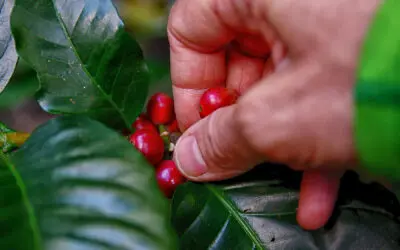Coffee is more than a single species. In fact, there are more that 120 species in the genus Coffea. Of these, four are cultivated industrially in the production of our favourite drink.
The four major species are arabica, robusta, liberica and excelsa. The first two are the dominant players but the others are variants of the one species and have a role regionally, adding valuable nuance to many much sought after blends.
If you have heard of any of them, Arabica may be the most familiar. Scientifically known as Coffea arabica, this genus/species accounts for somewhere in the region of 60-80% of the world’s coffee production, with second place going to Coffea canephora (20-40%) – popularly known as “robusta”. The other two, liberica and excelsa are actually classed together under the C.liberica species. Excelsa was for a time considered as its own species but has since been reclassified (2005) as a variant of liberica (C.liberica var. excelsa).
In the heady vortex of caffeinated consciousness, where the aroma of roasted beans dances with the whispers of far away places, these four beans each bring their own tale to the campfire, their own flavours to savour, and their own place in the grand story of global coffee production.
The following is an overview of each:
Arabica: The Premier
Arabica, the aristocrat of the coffee world, reigns supreme with its delicate flavour profile and intoxicating aroma. Legend has it that this noble bean was first discovered on that fateful day in the highlands of Ethiopia. Famously, the goat herder, Kaldi, observed his frolicking flock indulging in the crimson cherries of the coffee plant. He then muttered to himself, “I’ll have what they’re having”. Since then, Arabica has journeyed across continents, finding its home in the lush mountains of Latin America, Africa, and Asia.
With its smooth, nuanced taste, Arabica captivates the palate with notes of fruit, floral, and chocolate. Its cultivation demands meticulous care, thriving in high-altitude regions with ample rainfall and shade. From the misty slopes of the Colombian Andes to the sun-kissed plantations of Ethiopia’s Sidamo region, Arabica enchants coffee connoisseurs with its complexity and depth.
In the global coffee production supply chain, Arabica stands as the cornerstone. Its beans fetch a premium price, reflecting the craftsmanship and dedication of the farmers who nurture them. Arabica’s journey from bean to brew exemplifies the artistry and tradition that has elevated the coffee experience over centuries.
Robusta: The Maverick
Now, let’s head to the rugged terrain of the tropics. Amidst the emerald canopies of Southeast Asia and Africa, Robusta emerged as the fearless maverick of the coffee world. Whereas arabica came out of North Africa, robusta grew out of Sub-Saharan Africa, manifesting distinctly different qualities. Unlike its delicate northern counterpart Arabica, Robusta thrives in the lowlands, braving harsh conditions with unwavering resilience. Its journey began in the forests of West Africa, where indigenous tribes first cultivated this hearty species.
Robusta’s flavour profile is as bold as its spirit, with earthy, nutty tones and a hint of bitterness. The caffeine content surpasses that of Arabica, offering a robust kick, fuelling the more adventurous spirit. While Arabica looms large in the specialty coffee market, Robusta finds its place in espresso blends and instant coffee, lending depth and crema to the brew.
In the global coffee production supply chain, Robusta plays a pivotal role in second place of the world’s over all coffee output. Its hardy nature and high yields make it a staple in many coffee blends, providing a backbone of strength and character. From the plantations of Vietnam to the shores of Brazil, Robusta continues to carve its legacy in the annals of coffee history.
Liberica: The Voyager
Moving on to the mist-shrouded forests of West Africa, Liberica emerges as the exotic voyager of the coffee world. With its oversized beans and distinctive flavour profile, Liberica stands apart from its more familiar counterparts. Believed to have originated in Liberia, this rare species found its way to the shores of Southeast Asia, finding a place in the world’s second largest coffee producing nation, Viet Nam, where it flourishes in that region’s equatorial climate.
Liberica’s flavour is a tapestry of intrigue, with bold, smoky notes and a hint of floral sweetness. Its unique aroma evokes images of exotic lands and untamed wilderness, captivating the adventurous palate. While its production remains limited compared to Arabica and Robusta, Liberica holds a cherished place among coffee aficionados seeking rare and exotic brews.
In the global coffee production supply chain, Liberica occupies a niche market, representing a fraction of total output. Its cultivation requires specific environmental conditions, making it less prevalent than its more widely cultivated counterparts. Yet, for those who dare to explore its depths, Liberica offers a taste of the exotic, a glimpse into the untamed heart of coffee’s origins.
Excelsa: The Enigma
Venturing into the mysterious realms of Southeast Asia, Excelsa emerges as the enigmatic explorer of the coffee universe. With its eclectic flavour profile and captivating aroma, Excelsa invites the curious palate on a journey of discovery. Originating in the highlands of Southeast Asia, this elusive species thrives in the dappled shade of tropical forests.
Excelsa’s flavour is a mix of contradictions, with fruity, spicy notes and a hint of tartness. Its complexity intrigues the senses, inviting exploration with each sip. While its production remains limited compared to Arabica and Robusta, Excelsa holds a special place in the hearts of adventurous coffee lovers seeking new horizons.
In the global coffee production supply chain, Excelsa occupies a niche market, representing a small fraction of total output. Its cultivation requires specialized knowledge and care, making it less prevalent than more widely cultivated varieties. Yet, for those who dare to venture into uncharted territory, Excelsa offers a taste of the exotic, a glimpse into the undiscovered depths of coffee’s potential.
In Summary
Journeying through the vast landscape of coffee, these four prized beans, each with its own story to tell, its own flavour to savour, form the backbone of the coffee experience. From the noble elegance of Arabica to the bold spirit of Robusta, from the exotic allure of Liberica to the enigmatic charm of Excelsa, coffee beckons us to experiment. So, enquire with your local roasters and the adventurers who bring these treasures to your market shelves. Always seek to broaden your coffee horizons, and may your journey be as rich and rewarding as mine has been.
As always, please take a moment to share, follow, comment and subscribe to The Coffee Authority Weekly (if you have not already). Bean Indigo is a community made stronger by your support and participation. We look forward to your contributions.



0 Comments